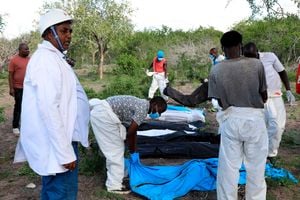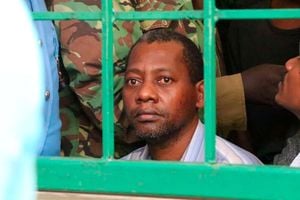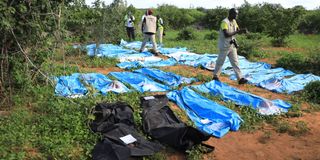
Bodies exhumed from mass graves in Shakahola forest, Kilifi County on May 12, 2023.
In 2023, tragedy struck the little-known Shakahola Forest in Kilifi County, where 429 people were confirmed dead due to religious extremism that saw them convinced to starve to death, with more than one third being minors, before being buried in shallow graves at the vast forest.
After the news broke, these numbers of lost lives were rising at a rate that shook the country, grabbing international limelight.
Tales by survivors who spoke to the Nation showed that those who died were told to fast nonstop in order to meet 'Jesus', while those who attempted to escape were killed, including children.

An aerial view shows the mass-grave site in Shakahola, outside the coastal town of Malindi, on April 25, 2023.
Nine months later, the 429 bodies continue to lay in a makeshift morgue in Kilifi, a stark reminder of the grim reality of religious extremism. These individuals, once vibrant and full of life, were pushed into a sorry state of existence, their lives cut short by the very beliefs they held dear.
The forest, once a sanctuary of nature’s beauty that was a cultural treasure to local communities, has now become a silent witness to the atrocities committed within its depths.
Shakahola, a village in Kilifi County, had suddenly been enveloped in an eerie silence for several months. The once lively and bustling settlement now appeared desolate, with its mud huts topped with makuti roofs casting spectral shadows across the terrain.
The once teeming pathways were now silent, as if the villagers had disappeared into thin air, leaving behind personal items such as Bibles, an evidence of their sudden departure.
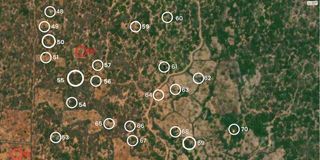
A map showing villages that were carved out of Shakahola Forest by adherents of a suspected cult, many of whom were allegedly convinced by their leader to fast to death or murdered.
In stark contrast to the usual friendly atmosphere of the village, a palpable tension hung in the air. Abandoned dishes covered in cobwebs suggested the ‘final meal’ of the followers of a cult that was allegedly led by Pastor Paul Mackenzie’s contentious Good News International Church, which had taken a dangerous turn towards a deadly fast.
In this tense environment, where a presumed cult was engrossed in apocalyptic prophecies, sadly, a number of them did not survive the journey to the Malindi Hospital.
Once they died in the forest, the victims were buried haphazardly in shallow graves, some by the dozens inside one grave. Their final resting places marked not by tombstones, but by vegetation cover that was apparently meant to hide the unfolding, chilling events.
A stark contrast to the need to rest in eternal peace, these bodies were exhumed months later, a grim task undertaken by those left behind. The bodies, now mere skeletal remains, were carefully preserved in a makeshift morgue, a haunting testament to the lives lost.
These individuals were marginalized and pushed to the fringes of society, their voices silenced by the deafening cries of extremism.
When their lives were so unjustly taken, the dignity they deserved in death was stripped away as well. Only those in the spirit would know if they actually met their God.
Nine months on, the makeshift morgue still stands, a grim reminder of the tragedy that unfolded.
The victims, in death as in life, remain caught in a state of limbo, their identities yet to be confirmed, their stories yet to be told.
Even in death, the cult denied them their identities, leaving the bodies ‘unidentified’ due to a lack of any documentation. The fact that some of these members came from far off counties in other regions in Kenya, made it more puzzling both in identifying and claiming the bodies.
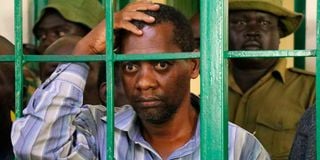
Pastor Paul Mackenzie appears before Shanzu Law Courts on June 2, 2023.
In the midst of a heart-wrenching situation, families grapple with the anguish of uncertainty, desperately seeking closure for their missing loved ones.
The haunting absence of information leaves them in a harrowing limbo, yearning for answers while confronting the stark reality that their relatives might be among the unidentified deceased. Despite their earnest efforts in providing DNA samples for identification, the cruel shroud of ambiguity persists, leaving families bereft of the crucial knowledge about the fate and whereabouts of their kin.
The agonising wait for news or confirmation adds immeasurable emotional strain to their already overwhelming ordeal.
In May, the government initiated a DNA initiative targeting families who suspect their missing or deceased relatives might be linked to the Kilifi’s Shakahola Forest.
Nearly seven months have passed since its launch, yet closure eludes them as they anxiously await the DNA outcomes.
Among those affected is Mr Rodgers Mwibo, whose mother, sister, and niece, devout followers of the controversial cult, relocated to the forest a year ago.
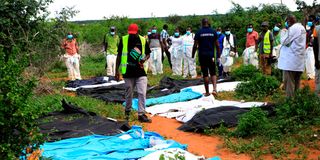
Bodies exhumed at Shakahola Forest during today's exercise being loaded to a Police Van in this photo taken on May 13, 2023.
Expressing his distress, Mr Mwibo shared that following the government's announcement, he promptly provided his DNA samples in both Nairobi and Malindi.
"Instead of finding solace, the prolonged wait only amplifies my trauma. Whenever I glance at my mother's photo, I long for her presence, even if it's just to bid her farewell," tearfully lamented Mr Mwibo, questioning the efficacy of the government's DNA procedures.
According to him, assurances were given that results would be promptly delivered post-DNA collection. However, what was promised as a brief period has extended to a year, leaving him and others in a state of emotional anguish.
"In what country do bodies remain stored in refrigerators while families endure this agony?" he exclaimed.
Another relative, Mary Mwikali is worried that she might never know whether her sister and niece are among those whose bodies were exhumed from the forest.
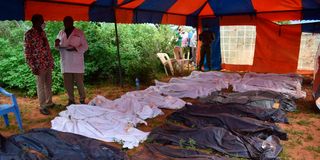
Some of the 26 bodies that were exhumed from a mass grave site at Shakahola Village in Kilifi County on April 24, 2023.
The agonising wait persists, leaving them grappling with uncertainty about whether their loved ones are still alive or among the 400-plus individuals at rest in the Malindi Sub County Hospital morgue.
The Rapid Response Officer at Haki Africa Mathias Shipeta raised concerns about the extensive duration required for DNA matching.
"Families are closing the year without knowing the whereabouts of their kin. It's not clear to them whether they are dead or alive. To put closure to this matter, DNA matching must be completed in time," Mr Shipeta said.
In May, the government launched a DNA drive for families who believe their relatives are among those missing or found dead in the Kilifi’s Shakahola forest. But they have not found closure as they await DNA results. In July, 266 DNA were collected for identification purposes.
A DNA exam is the scientific matching of genetic profiles of unidentified or dead people with those of identified people (dead or alive). In DNA processing, samples of muscle and bone tissues and teeth are collected. The profiles are then matched with those of immediate family members to check if they fit the profile.
Results from the comparison of samples are usually given through a computer-generated report in the form of percentages.


